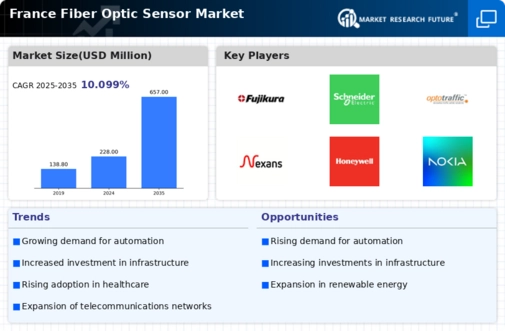Government Initiatives and Funding
Government initiatives in France are playing a crucial role in propelling the fiber optic-sensor market. The French government has launched several funding programs aimed at promoting research and development in advanced sensor technologies. These initiatives are designed to enhance the competitiveness of the local industry and encourage innovation. For example, the French National Research Agency has allocated approximately €50 million for projects focusing on the development of fiber optic sensors for environmental monitoring. Such funding not only supports technological advancements but also fosters collaboration between academic institutions and industry players. As a result, the fiber optic-sensor market is likely to benefit from increased investment and innovation, positioning it for substantial growth in the coming years.
Rising Demand for Real-Time Monitoring
The fiber optic-sensor market in France is experiencing a notable increase in demand for real-time monitoring solutions across various sectors. Industries such as oil and gas, telecommunications, and civil engineering are increasingly adopting fiber optic sensors for their ability to provide continuous data on temperature, pressure, and strain. This trend is driven by the need for enhanced safety and efficiency in operations. For instance, the oil and gas sector has reported a growth of approximately 15% in the adoption of these sensors, as they facilitate early detection of potential hazards. Furthermore, the integration of these sensors into smart grid technologies is expected to bolster the market, as they enable better management of energy resources. Thus, the rising demand for real-time monitoring is a significant driver for the fiber optic-sensor market in France.
Increased Focus on Industrial Automation
The trend towards industrial automation in France is significantly influencing the fiber optic-sensor market. As industries strive for greater efficiency and productivity, the integration of advanced sensor technologies becomes essential. Fiber optic sensors offer advantages such as immunity to electromagnetic interference and the ability to operate in harsh environments, making them ideal for automated systems. The manufacturing sector, in particular, is witnessing a shift towards smart factories, where fiber optic sensors are employed for monitoring equipment health and process optimization. Reports suggest that the industrial automation market in France is projected to grow by 10% annually, further driving the demand for fiber optic sensors. Thus, the increased focus on industrial automation serves as a vital driver for the fiber optic-sensor market.
Growing Adoption in Healthcare Applications
The healthcare sector in France is increasingly recognizing the advantages of fiber optic sensors, which is driving growth in the fiber optic-sensor market. These sensors are utilized for various applications, including patient monitoring, surgical procedures, and diagnostic imaging. Their ability to provide precise measurements and real-time data is particularly valuable in critical care settings. Recent studies indicate that the use of fiber optic sensors in medical applications has grown by approximately 20% over the past few years. This trend is expected to continue as healthcare providers seek to improve patient outcomes and operational efficiency. Consequently, the growing adoption of fiber optic sensors in healthcare applications is a significant market driver, reflecting the technology's versatility and effectiveness.
Emerging Applications in Structural Health Monitoring
The fiber optic-sensor market is being propelled by emerging applications in structural health monitoring across France. With the aging infrastructure and the need for regular maintenance, there is a growing emphasis on technologies that can provide real-time data on the condition of structures such as bridges, dams, and buildings. Fiber optic sensors are particularly suited for this purpose due to their ability to detect minute changes in strain and temperature. Recent projects have demonstrated that the implementation of these sensors can reduce maintenance costs by up to 30%. As awareness of the benefits of structural health monitoring increases, the fiber optic-sensor market is likely to see substantial growth driven by these emerging applications.



















Leave a Comment